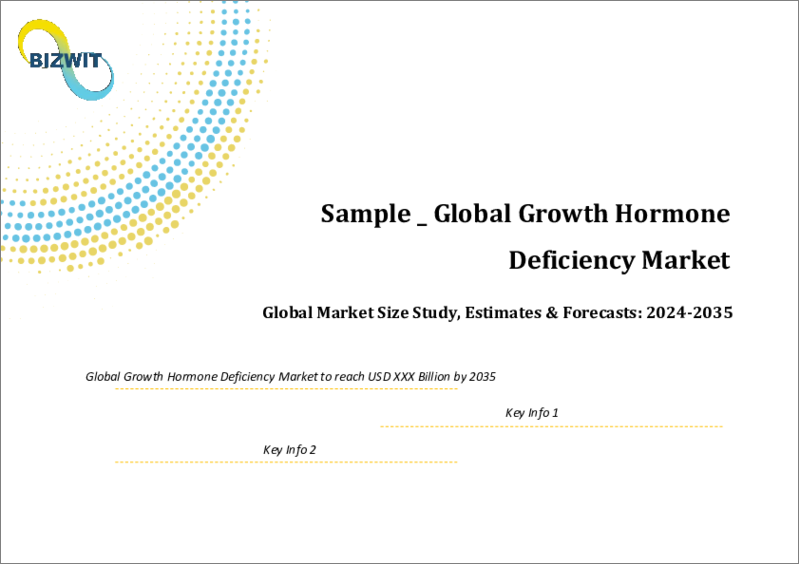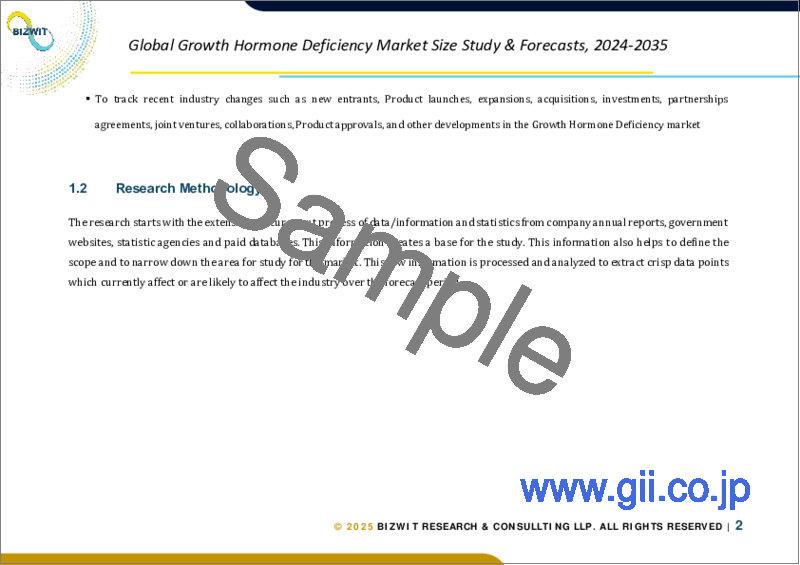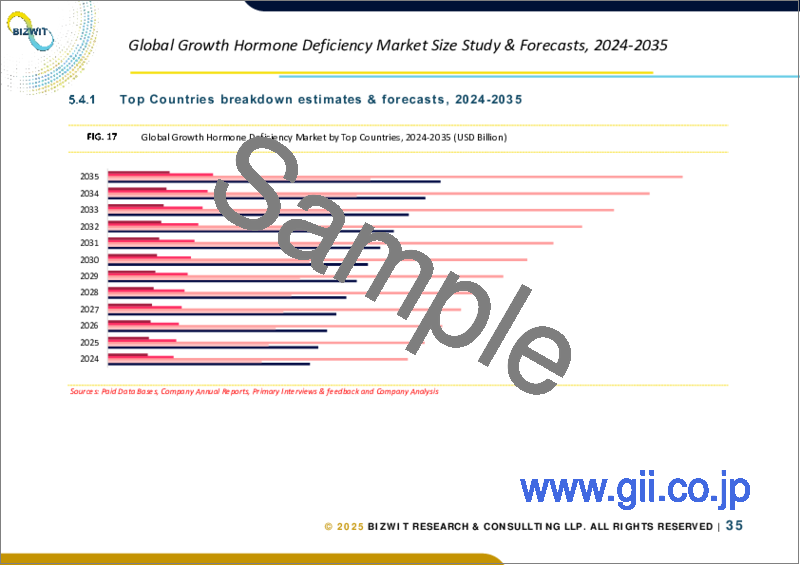|
|
市場調査レポート
商品コード
1529456
成長ホルモン分泌不全症の世界市場規模調査:治療タイプ別、適応疾患別、投与経路別、流通チャネル別、地域別予測、2022年~2032年Global Growth Hormone Deficiency Market Size study, by Treatment Type, by Disease Indication, by Route of Administration, by Distribution Channel and Regional Forecasts 2022-2032 |
||||||
カスタマイズ可能
|
|||||||
| 成長ホルモン分泌不全症の世界市場規模調査:治療タイプ別、適応疾患別、投与経路別、流通チャネル別、地域別予測、2022年~2032年 |
|
出版日: 2024年08月05日
発行: Bizwit Research & Consulting LLP
ページ情報: 英文 285 Pages
納期: 2~3営業日
|
全表示
- 概要
- 目次
世界の成長ホルモン分泌不全症市場は、2023年に約43億8,000万米ドルと評価され、予測期間2024-2032年には4.49%以上の健全な成長率で成長すると予測されています。
成長ホルモン分泌不全症(GHD)とは、成長ホルモンが体内で十分に分泌されない病態のことで、小児では成長と発育を、成人では組織や臓器の健康維持を担う重要な物質です。子どもの場合、GHDは同年齢の子どもに比べて身長が著しく低く、思春期が遅れ、顔やお腹の周りの脂肪が増加します。成人では、骨密度の低下、筋肉量の減少、疲労、心血管疾患のリスクの上昇などの症状がみられます。診断には多くの場合、ホルモンレベルを測定する血液検査、刺激試験、脳の画像検査が行われます。治療には通常、合成成長ホルモンを定期的に注射する成長ホルモン補充療法が含まれ、成長と代謝機能の正常化を助けます。早期診断と一貫した治療は、GHD患者の予後と生活の質を改善するために極めて重要です。
世界の成長ホルモン分泌不全症市場は、世界の成長ホルモン分泌不全症の罹患率の上昇が市場成長の主な触媒となっています。さらに、ホルモンバランスが崩れやすい老年人口が増加していることも、成長ホルモン治療に対する需要をさらに押し上げています。さらに、ホルモン分泌不全症に対する意識の高まりは、市場の拡大を後押しすると予想されます。成長ホルモン治療は、成長ホルモン分泌不全症に関連する様々な症状の早期診断と効果的な管理を可能にする上で重要な役割を果たしています。しかし、成長ホルモン治療の管理・モニタリングに必要な熟練した専門家の不足などの課題に直面しています。さらに、治療レジメンの複雑さと潜在的な副作用が市場成長の妨げになる可能性があります。
成長ホルモン分泌不全症の世界市場調査において考慮した主要地域は、アジア太平洋地域、北米、欧州、ラテンアメリカ、その他世界のその他の地域です。2023年には、北米が成長ホルモン療法を支配しており、この動向は予測期間を通じて続くと予想されます。この地域優位性は、米国の有利な償還政策と確立されたヘルスケアインフラに起因しています。さらに、アジア太平洋地域は、ヘルスケア投資の増加と成長ホルモン分泌不全症に対する意識の高まりにより、大幅な成長が見込まれています。
目次
第1章 成長ホルモン分泌不全症の世界市場エグゼクティブサマリー
- 成長ホルモン分泌不全症の世界市場規模・予測(2022~2032年)
- 地域別概要
- セグメント別概要
- 治療タイプ別
- 適応疾患別
- 投与経路別
- 販売チャネル別
- 主要動向
- 景気後退の影響
- アナリストの結論・提言
第2章 世界の成長ホルモン分泌不全症市場定義と調査前提条件
- 調査目的
- 市場の定義
- 調査前提条件
- 包含と除外
- 制限事項
- 供給サイドの分析
- 入手可能性
- インフラ
- 規制環境
- 市場競争
- 経済性(消費者の視点)
- 需要サイド分析
- 規制の枠組み
- 技術の進歩
- 環境への配慮
- 消費者の意識と受容
- 調査手法
- 調査対象年
- 通貨換算レート
第3章 成長ホルモン分泌不全症の世界市場力学
- 市場促進要因
- 成長ホルモン分泌不全症の発生率の増加
- 老人人口の増加
- 市場の課題
- 熟練した専門家の不足
- 治療レジメンの複雑さ
- 市場機会
- ホルモン分泌不全症に対する意識の高まり
- 治療手法の進歩
- 新興市場におけるヘルスケア投資の増加
第4章 成長ホルモン分泌不全症の世界市場産業分析
- ポーターのファイブフォースモデル
- 供給企業の交渉力
- 買い手の交渉力
- 新規参入業者の脅威
- 代替品の脅威
- 競争企業間の敵対関係
- ポーターのファイブフォースモデルへの未来的アプローチ
- ポーターのファイブフォースの影響分析
- PESTEL分析
- 政治
- 経済
- 社会
- 技術
- 環境
- 法律
- 主な投資機会
- 主要成功戦略
- 破壊的動向
- 業界専門家の視点
- アナリストの結論・提言
第5章 成長ホルモン分泌不全症の世界市場規模と予測:治療タイプ別、2022年~2032年
- セグメントダッシュボード
- 成長ホルモン分泌不全症の世界市場:収益動向分析、2022年・2032年
- 治療薬
- 遺伝子組み換えヒト成長ホルモン
- ヒト下垂体腺抽出物
- 外科手術
第6章 成長ホルモン分泌不全症の世界市場規模と予測:適応疾患別、2022年~2032年
- セグメントダッシュボード
- 成長ホルモン分泌不全症の世界市場:収益動向分析、2022年・2032年
- 小児成長ホルモン分泌不全症
- 特発性低身長症
- 低出生体重児
- ターナー症候群
- 成人成長ホルモン分泌不全症
- その他(プラダー・ウィリー症候群など)
第7章 成長ホルモン分泌不全症の世界市場規模と予測:投与経路別、2022年~2032年
- セグメントダッシュボード
- 成長ホルモン分泌不全症の世界市場:収益動向分析、2022年・2032年
- 皮下投与
- 筋肉内
- 静脈内投与
第8章 成長ホルモン分泌不全症の世界市場規模と予測:流通チャネル別、2022年~2032年
- セグメントダッシュボード
- 成長ホルモン分泌不全症の世界市場:収益動向分析、2022年・2032年
- 病院薬局
- 小売薬局
- オンライン薬局
第9章 成長ホルモン分泌不全症の世界市場規模と予測:地域別、2022年~2032年
- 北米
- 米国
- カナダ
- 欧州
- 英国
- ドイツ
- フランス
- スペイン
- イタリア
- その他欧州
- アジア太平洋
- 中国
- インド
- 日本
- オーストラリア
- 韓国
- その他アジア太平洋地域
- ラテンアメリカ
- ブラジル
- メキシコ
- その他ラテンアメリカ
- 中東・アフリカ
- サウジアラビア
- 南アフリカ
- その他中東とアフリカ
第10章 競合情報
- 主要企業のSWOT分析
- 主要市場戦略
- 企業プロファイル
- Novo Nordisk A/S
- 主要情報
- 概要
- 財務(データの入手可能性によります)
- 製品概要
- 市場戦略
- Pfizer Inc.
- Merck KGaA
- Eli Lilly and Company
- Novartis AG
- F. Hoffmann-La Roche AG
- Ipsen Pharma
- Ferring Pharmaceuticals
- Anhui Anke Biotechnology(Group)Co., Ltd.
- Zhongshan Sinobioway Hygene Biomedicine Co., Ltd.
- Novo Nordisk A/S
第11章 調査プロセス
- 調査プロセス
- データマイニング
- 分析
- 市場推定
- 検証
- 出版
- 調査属性
Global Growth Hormone Deficiency Market is valued approximately at USD 4.38 billion in 2023 and is anticipated to grow with a healthy growth rate of more than 4.49% over the forecast period 2024-2032. Growth Hormone Deficiency (GHD) is a medical condition where the body does not produce enough growth hormone, a critical substance responsible for growth and development in children and maintaining tissue and organ health in adults. In children, GHD can result in significantly shorter stature compared to peers, delayed puberty, and increased fat around the face and stomach. In adults, symptoms might include reduced bone density, decreased muscle mass, fatigue, and a higher risk of cardiovascular diseases. Diagnosis often involves blood tests to measure hormone levels, stimulation tests, and imaging studies of the brain. Treatment typically includes growth hormone replacement therapy, which involves regular injections of synthetic growth hormone, helping to normalize growth and metabolic functions. Early diagnosis and consistent treatment are crucial for improving outcomes and quality of life for individuals with GHD.
The Global Growth Hormone Deficiency Market is driven by rising incidence of growth hormone deficiencies worldwide is a primary catalyst for market growth. Additionally, the increasing geriatric population, who are more prone to hormonal imbalances, further propels the demand for growth hormone treatments. Furthermore, growing awareness about hormonal deficiencies is anticipated to bolster market expansion. Growth hormone treatments play a critical role in enabling early diagnosis and effective management of various conditions associated with growth hormone deficiency. However, the market faces challenges, such as the shortage of skilled professionals required to administer and monitor growth hormone therapies. Additionally, the complexity of treatment regimens and potential side effects may hinder market growth.
The key regions considered for the Global Growth Hormone Deficiency Market study includes Asia Pacific, North America, Europe, Latin America, and Rest of the World. In 2023, North America dominated the growth hormone therapy landscape, a trend expected to continue throughout the forecast period. This regional dominance is attributed to favorable reimbursement policies in the U.S. and a well-established healthcare infrastructure. Furthermore, Asia-Pacific region is anticipated to witness substantial growth, driven by increasing healthcare investments and rising awareness about growth hormone deficiencies.
Major market players included in this report are:
- Novo Nordisk A/S
- Pfizer Inc.
- Merck KGaA
- Eli Lilly and Company
- Novartis AG
- F. Hoffmann-La Roche AG
- Ipsen Pharma
- Ferring Pharmaceuticals
- Anhui Anke Biotechnology (Group) Co., Ltd.
- Zhongshan Sinobioway Hygene Biomedicine Co., Ltd.
The detailed segments and sub-segment of the market are explained below:
By Treatment Type:
- Therapeutic Treatment
- Recombinant Human Growth Hormone
- Human Pituitary Gland Extracts
- Surgery
By Disease Indication:
- Pediatric Growth Hormone Deficiency
- Idiopathic Short Stature
- Small for Gestational Age
- Turner Syndrome
- Adult Growth Hormone Deficiency
- Others (Prader-Willi Syndrome, etc.)
By Route of Administration:
- Subcutaneous
- Intramuscular
- Intravenous
By Distribution Channel:
- Hospital Pharmacies
- Retail Pharmacies
- Online Pharmacies
By Region:
- North America
- U.S.
- Canada
- Europe
- UK
- Germany
- France
- Spain
- Italy
- ROE
- Asia Pacific
- China
- India
- Japan
- Australia
- South Korea
- RoAPAC
- Latin America
- Brazil
- Mexico
- RoLA
- Middle East & Africa
- Saudi Arabia
- South Africa
- RoMEA
Years considered for the study are as follows:
- Historical year - 2022
- Base year - 2023
- Forecast period - 2024 to 2032
Key Takeaways:
- Market Estimates & Forecast for 10 years from 2022 to 2032.
- Annualized revenues and regional level analysis for each market segment.
- Detailed analysis of geographical landscape with Country level analysis of major regions.
- Competitive landscape with information on major players in the market.
- Analysis of key business strategies and recommendations on future market approach.
- Analysis of competitive structure of the market.
- Demand side and supply side analysis of the market
Table of Contents
Chapter 1. Global Growth Hormone Deficiency Market Executive Summary
- 1.1. Global Growth Hormone Deficiency Market Size & Forecast (2022- 2032)
- 1.2. Regional Summary
- 1.3. Segmental Summary
- 1.3.1. By Treatment Type
- 1.3.2. By Disease Indication
- 1.3.3. By Route of Administration
- 1.3.4. By Distribution Channel
- 1.4. Key Trends
- 1.5. Recession Impact
- 1.6. Analyst Recommendation & Conclusion
Chapter 2. Global Growth Hormone Deficiency Market Definition and Research Assumptions
- 2.1. Research Objective
- 2.2. Market Definition
- 2.3. Research Assumptions
- 2.3.1. Inclusion & Exclusion
- 2.3.2. Limitations
- 2.3.3. Supply Side Analysis
- 2.3.3.1. Availability
- 2.3.3.2. Infrastructure
- 2.3.3.3. Regulatory Environment
- 2.3.3.4. Market Competition
- 2.3.3.5. Economic Viability (Consumer's Perspective)
- 2.3.4. Demand Side Analysis
- 2.3.4.1. Regulatory frameworks
- 2.3.4.2. Technological Advancements
- 2.3.4.3. Environmental Considerations
- 2.3.4.4. Consumer Awareness & Acceptance
- 2.4. Estimation Methodology
- 2.5. Years Considered for the Study
- 2.6. Currency Conversion Rates
Chapter 3. Global Growth Hormone Deficiency Market Dynamics
- 3.1. Market Drivers
- 3.1.1. Rise in Incidence of Growth Hormone Deficiencies
- 3.1.2. Increase in Geriatric Population
- 3.2. Market Challenges
- 3.2.1. Lack of Skilled Professionals
- 3.2.2. Complexity of Treatment Regimens
- 3.3. Market Opportunities
- 3.3.1. Growing Awareness about Hormonal Deficiencies
- 3.3.2. Advancements in Treatment Methodologies
- 3.3.3. Increasing Healthcare Investments in Emerging Markets
Chapter 4. Global Growth Hormone Deficiency Market Industry Analysis
- 4.1. Porter's 5 Force Model
- 4.1.1. Bargaining Power of Suppliers
- 4.1.2. Bargaining Power of Buyers
- 4.1.3. Threat of New Entrants
- 4.1.4. Threat of Substitutes
- 4.1.5. Competitive Rivalry
- 4.1.6. Futuristic Approach to Porter's 5 Force Model
- 4.1.7. Porter's 5 Force Impact Analysis
- 4.2. PESTEL Analysis
- 4.2.1. Political
- 4.2.2. Economical
- 4.2.3. Social
- 4.2.4. Technological
- 4.2.5. Environmental
- 4.2.6. Legal
- 4.3. Top investment opportunity
- 4.4. Top winning strategies
- 4.5. Disruptive Trends
- 4.6. Industry Expert Perspective
- 4.7. Analyst Recommendation & Conclusion
Chapter 5. Global Growth Hormone Deficiency Market Size & Forecasts by Treatment Type 2022-2032
- 5.1. Segment Dashboard
- 5.2. Global Growth Hormone Deficiency Market: Treatment Type Revenue Trend Analysis, 2022 & 2032 (USD Billion)
- 5.2.1. Therapeutic Treatment
- 5.2.2. Recombinant Human Growth Hormone
- 5.2.3. Human Pituitary Gland Extracts
- 5.2.4. Surgery
Chapter 6. Global Growth Hormone Deficiency Market Size & Forecasts by Disease Indication 2022-2032
- 6.1. Segment Dashboard
- 6.2. Global Growth Hormone Deficiency Market: Disease Indication Revenue Trend Analysis, 2022 & 2032 (USD Billion)
- 6.2.1. Pediatric Growth Hormone Deficiency
- 6.2.2. Idiopathic Short Stature
- 6.2.3. Small for Gestational Age
- 6.2.4. Turner Syndrome
- 6.2.5. Adult Growth Hormone Deficiency
- 6.2.6. Others (Prader-Willi Syndrome, etc.)
Chapter 7. Global Growth Hormone Deficiency Market Size & Forecasts by Route of Administration 2022-2032
- 7.1. Segment Dashboard
- 7.2. Global Growth Hormone Deficiency Market: Route of Administration Revenue Trend Analysis, 2022 & 2032 (USD Billion)
- 7.2.1. Subcutaneous
- 7.2.2. Intramuscular
- 7.2.3. Intravenous
Chapter 8. Global Growth Hormone Deficiency Market Size & Forecasts by Distribution Channel 2022-2032
- 8.1. Segment Dashboard
- 8.2. Global Growth Hormone Deficiency Market: Distribution Channel Revenue Trend Analysis, 2022 & 2032 (USD Billion)
- 8.2.1. Hospital Pharmacies
- 8.2.2. Retail Pharmacies
- 8.2.3. Online Pharmacies
Chapter 9. Global Growth Hormone Deficiency Market Size & Forecasts by Region 2022-2032
- 9.1. North America Growth Hormone Deficiency Market
- 9.1.1. U.S. Growth Hormone Deficiency Market
- 9.1.1.1. Treatment Type breakdown size & forecasts, 2022-2032
- 9.1.1.2. Disease Indication breakdown size & forecasts, 2022-2032
- 9.1.1.3. Route of Administration breakdown size & forecasts, 2022-2032
- 9.1.1.4. Distribution Channel breakdown size & forecasts, 2022-2032
- 9.1.2. Canada Growth Hormone Deficiency Market
- 9.1.1. U.S. Growth Hormone Deficiency Market
- 9.2. Europe Growth Hormone Deficiency Market
- 9.2.1. U.K. Growth Hormone Deficiency Market
- 9.2.2. Germany Growth Hormone Deficiency Market
- 9.2.3. France Growth Hormone Deficiency Market
- 9.2.4. Spain Growth Hormone Deficiency Market
- 9.2.5. Italy Growth Hormone Deficiency Market
- 9.2.6. Rest of Europe Growth Hormone Deficiency Market
- 9.3. Asia-Pacific Growth Hormone Deficiency Market
- 9.3.1. China Growth Hormone Deficiency Market
- 9.3.2. India Growth Hormone Deficiency Market
- 9.3.3. Japan Growth Hormone Deficiency Market
- 9.3.4. Australia Growth Hormone Deficiency Market
- 9.3.5. South Korea Growth Hormone Deficiency Market
- 9.3.6. Rest of Asia Pacific Growth Hormone Deficiency Market
- 9.4. Latin America Growth Hormone Deficiency Market
- 9.4.1. Brazil Growth Hormone Deficiency Market
- 9.4.2. Mexico Growth Hormone Deficiency Market
- 9.4.3. Rest of Latin America Growth Hormone Deficiency Market
- 9.5. Middle East & Africa Growth Hormone Deficiency Market
- 9.5.1. Saudi Arabia Growth Hormone Deficiency Market
- 9.5.2. South Africa Growth Hormone Deficiency Market
- 9.5.3. Rest of Middle East & Africa Growth Hormone Deficiency Market
Chapter 10. Competitive Intelligence
- 10.1. Key Company SWOT Analysis
- 10.2. Top Market Strategies
- 10.3. Company Profiles
- 10.3.1. Novo Nordisk A/S
- 10.3.1.1. Key Information
- 10.3.1.2. Overview
- 10.3.1.3. Financial (Subject to Data Availability)
- 10.3.1.4. Product Summary
- 10.3.1.5. Market Strategies
- 10.3.2. Pfizer Inc.
- 10.3.3. Merck KGaA
- 10.3.4. Eli Lilly and Company
- 10.3.5. Novartis AG
- 10.3.6. F. Hoffmann-La Roche AG
- 10.3.7. Ipsen Pharma
- 10.3.8. Ferring Pharmaceuticals
- 10.3.9. Anhui Anke Biotechnology (Group) Co., Ltd.
- 10.3.10. Zhongshan Sinobioway Hygene Biomedicine Co., Ltd.
- 10.3.1. Novo Nordisk A/S
Chapter 11. Research Process
- 11.1. Research Process
- 11.1.1. Data Mining
- 11.1.2. Analysis
- 11.1.3. Market Estimation
- 11.1.4. Validation
- 11.1.5. Publishing
- 11.2. Research Attributes






